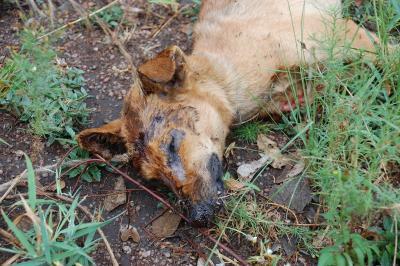Phylodynamics and inference from rabies sequence data

We were joined by researchers from the rabies unit at the Animal and Plant Health Agency (APHA) who serve as the reference laboratory for the World Organization for Animal Health (OIE) and are a World Health Organization (WHO) Collaborating Centre for Rabies Research and from the bioinformatics and spatial processes group at INRA, Avignon, France.
We spanned a range of scales in terms of transmission, techniques and species:
Kirstyn Brunker discussed her work on phylodynamics across continental scales in Africa, whilst Dan Horton from the University of Sussex provided an interesting contrast in the Middle East. Kirstyn also presented on dissecting more local landscape drivers of dispersal in collaboration with Philippe Lemey, whilst Samuel Soubeyrand looked at how genetics can help to identify individual pathways of transmission.
Nardus Mollentze presented on cross-species transmission including repeat epidemics of rabies in kudu in Southern Africa, in collaboration with Louis Nel from the Univeristy of Pretoria. Richard Orton provided interesting parallels from his work on another fast evolving pathogen, foot-and-mouth disease virus.
We finished with a global tour of rabies, literally from current global plans for canine rabies control from Sarah Cleaveland; a review of progress from large-scale control efforts in Tanzania from Katie Hampson; insights into the North American terrestrial wildlife rabies from Roman Biek and finally Daniel Streicker and Julio Benavides provided a great double act on the increasing problem of vampire bat rabies and where new opportunities might lie.
This was a great day for consolidating collaborations and thinking about new avenues and future work, as always benefiting from whisky fueled discussions (with particular contributions from Tony Fooks) in our local establishments.
Schedule
- Cross-species transmission & Viral evolution – (UG)
- Large-scale and local-scale phylodynamics – Kirstyn Brunker(UG)
- Phylodynamics in the Middle-East – Dan Horton (University of Sussex)
- Deep sequencing & Whole genome sequencing
- Approaches for rabies – Denise Marston (APHA)
- Approaches from other viruses – Richard Orton (UG)
- Tracing transmission pathways – Samuel Soubeyrand (INRA)
- Rabies Control – Current control challenges and contributions of genetics
- Overview of global discussions for WHO meeting in Dec – Sarah Cleaveland (UG)
- Canine rabies in Tanzania – Katie Hampson (UG)
- Spatial expansions of vampire bat rabies – Julio Benavides (UG)
- Bat-rabies virus population genetics – Daniel Streicker (UG)
- Oral Rabies Vaccination in N America – Roman Biek (UG)

